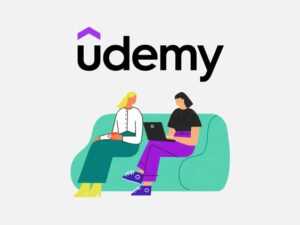Master English Grammar: A1, A2, B1, B2 Levels
- Description
- Curriculum
- FAQ
- Reviews
- Grade

English grammar can be tricky, but with the right guidance and practice, you can master it at any level. That’s exactly what our Master English Grammar course offers, covering A1, A2, B1, and B2 levels of the Common European Framework of Reference for Languages (CEFR).
This comprehensive course covers all aspects of English grammar, from the basics of sentence structure to advanced verb tenses and idiomatic expressions. It is designed to provide a logical progression through the language, building on previous knowledge and skills.
Throughout the course, you will engage in interactive exercises, quizzes, and practice activities to apply and reinforce what you have learned. You will also have access to a wealth of authentic English materials, such as texts, audio, and videos, to help you understand how grammar is used in real-life situations.
The course is taught by certified English teachers who have a wealth of knowledge and experience in teaching grammar.
Whether you’re a beginner just starting out or an intermediate learner looking to advance to the next level, this course has everything you need to master English grammar. Enroll now and start your journey to fluency today!
Our My Teacher Academy course has helped thousands of students around the world improve their English speaking and comprehension. Our expert instructors have carefully crafted a program that combines traditional lectures with interactive practice exercises to cater to all learning styles.
This course is designed to provide a solid understanding of English grammar, with checkpoint reviews to gauge your understanding and ensure you complete the course with confidence.
This course includes:
-
Comprehensive grammar and vocabulary lessons to improve your English.
-
Downloadable (pdf) materials for easy access.
-
Subtitled video lectures that explain grammar topics in an easy-to-understand way.
-
Various exercises to aid comprehension.
Begin learning English at your own pace and improve your skills through our high-quality courses and resources, all designed for adult language learners. We also offer business English courses and online speaking classes on our site.
This course aligns with the following levels:
-
From Cambridge University in the UK: Starters, Flyers, Preliminary English Test (PET), First Certificate Exam (FCE)
-
From the Common European Framework of Reference for Languages (CEFR): A1, A2, B1, B2
-
For the TOEFL Exam (Test Of English as a Foreign Language): 87-109 points
WHAT WILL YOU LEARN: (COURSE CONTENT)
In this course you will gain an extensive grammar knowledge needed for the official exams.
You will learn the Past Simple, Past Continuous and their differences, the proper way to express habits in the past using Used to & Would, Past Perfect Simple, the differences between Past Simple and Past Perfect, the Future simple, the structure “to be going to” and Present Simple for the future and their differences in use. You will also learn the Use of Gerunds and Infinitives. You will also learn the structure and our easy methods to create a sentence in Passive, in Reported Speech, and in First, Second and Zero Conditionals. Another important lesson you will learn will be the order of the adjectives in a sentence.
You will learn the how to create and the differences in use between most verb tenses such as Present Perfect Simple or Present Perfect Continuous, between Past Perfect Simple and Past Perfect Continuous, or between all the different verb tenses we can use for the future, like Future Simple, Be going to, Present Continuous, Present Simple,Future Continuous, Future Perfect or to be about to.
You will know the differences and when to use an adjective ending in +ed or +ing, as well as how to create a Passive form in any verb tense, the Passive with Reporting verbs, or the Passive with two objects.
You will also find videos explaining how to create a modal verb structure for the past, and the Third Conditional structure.
In the last section you will learn one of the most difficult grammar lessons, that is when we can ommit a Relative clause or when we can´t, and the differences between a Defining and a Non-defining Relative Clause and their implications.
WHAT YOU WILL GAIN AFTER THE COURSE:
After finishing this course you will be able to have a deep knowledge of the English grammar, and be capable of reading and writing using advanced English grammar, as well as being able to have a solid grammar base to have a perfect conversation in English.
About us:
We are a team of certified English instructors from various backgrounds who noticed that many students struggle to master English grammar or speak confidently despite hours of study. To address this, we developed our own unique method that has helped over 50,000 students in 166 countries around the world. With our method, you can achieve the fluency and confidence you need to speak English without worrying about grammar rules. Let us help you reach your full potential in the language.
-
3Strategies for your overall learning experience
-
4Strategies for your vocabulary learning
-
5Strategies to enhance your writing skills
-
6Improve your speaking skills
-
7Strategies to enhance your speaking skills
Before you start this course, here I want to give you some tips on how you can improve your speaking skills.
-
8Using Complex Sentences in your speech
-
9Strategies for your grammar learning
-
10Strategies to enhance your listening skills
-
11Strategies to enhance your reading skills
-
12Your opinion matters to us!
-
13Reminder of Prepositional Phrases
A prepositional phrase is a group of words that includes a preposition (like "in," "on," "at," "with," etc.) and its object (a noun or pronoun).
It is used to describe the relationship between different parts of a sentence. For example, in the sentence "The book is on the table," "on the table" is a prepositional phrase, where "on" is the preposition, and "the table" is its object.
Prepositional phrases add more information and context to sentences, making them clearer and more detailed.
Please watch the video and make sure you memorize and use them in your speaking.
-
14Test this vocabulary
-
15Reminder of Adjectives A2, B1, B2 levels
-
16Test this vocabulary
-
17Adjectives to describe people
-
18Test this vocabulary
-
19Learning new words through synonyms
-
20Test this vocabulary
-
21Verbs to review and consolidate A2, B1, B2 levels
-
22Test this vocabulary
-
32The Present Simple
In this video we are going to explain to you how to create and use the Present Simple tense. The most common verb tense in English.
-
33Exercise with guided solutions
-
34Grammar: Present Simple & the verb to be
-
35Exercise with guided solutions
-
36Grammar: Present Simple
-
37Exercise with guided solutions
-
38Present Simple Review Test
-
39Grammar: The WASV formula to create questions
This is a very important lesson. We created the WASV? formula so you can use it when you need to ask a question.
Always use this formula to remember how to create a question because you can use it in all verbal tenses.
-
40Exercise with guided solutions
-
41The WASV Formula
-
42Exercise with guided solutions
-
43The WASV? Formula Review Test
-
44Adverbs of Frequency
-
45Exercise with guided solutions
-
46Adverbs of Frequency
-
47Exercise with guided solutions
-
48Adverbs of Frequency Review Test
-
49Demonstrative Pronouns
In this lesson we are going to show you how to use the words “this, that, these or those”.
-
50Exercise with guided solutions
-
51Demonstrative Pronouns Review Test
-
52How to Identify a Subject
In this lesson you will learn how to identify the subject of the sentence.
-
53How to identify a Subject Review Test
-
54Articles: A, An, The, Nothing
In this lesson we are going to show you how to introduce a person or thing in a conversation with the words “a” “the” or nothing, and when to use them.
-
55Exercise with guided solutions
-
56Articles: A, An, The, Nothing Review Test
-
57How to create a Sentence
In this video we are going to explain to you how the sentences are created in English, their order and elements.
-
58Exercise with guided solutions
-
59Grammar: How to create a sentence in English
-
60The possessive genitive: ´s
In this video we´re going to show you how to use the possessive "´s" .
-
61There is or There are
In this lesson you will learn when to use there is or there are.
-
62Exercise with guided solutions
-
63Grammar: There is / are (1)
-
64Exercise with guided solutions
-
65Grammar: There is / are (2)
-
66Some or Any
In this video we show you the differences between "some" and "any" and when to use them.
-
67Exercise with guided solutions
-
68Exercise with guided solutions
-
69Some or Any Review Test
-
70How much or How many
In this video we show you the differences between "How much" and "How many" and when to use them.
-
71Exercise with guided solutions
-
72How much or How many Review Test
-
73Much, Many, A lot of
In this video we show you the differences between "much", "many" and "a lot of" and when to use each one.
-
74Exercise with guided solutions
-
75Exercise with guided solutions
-
76Much, many, a lot of Review Test
-
77Grammar: much / many / a lot of (2)
-
78A little, a few Review Test
-
79Exercise with guided solutions
-
80Exercise with guided solutions
-
81Too much or too many?











